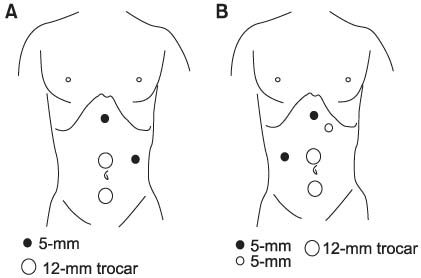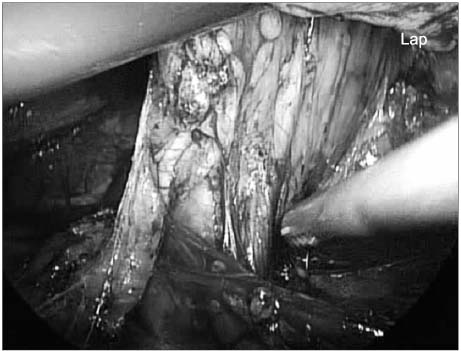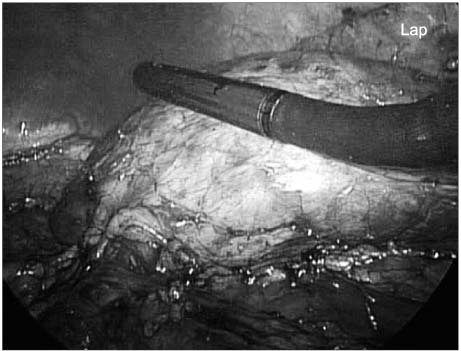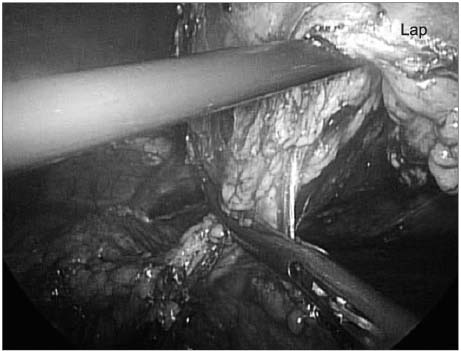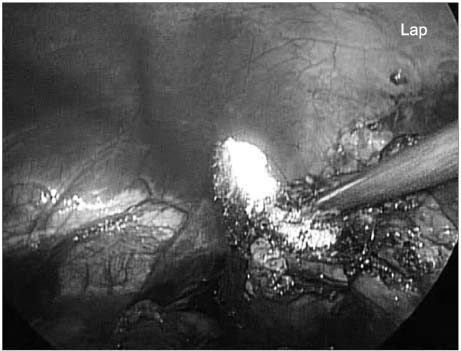Korean J Urol.
2006 Oct;47(10):1052-1058. 10.4111/kju.2006.47.10.1052.
Laparoscopic Nephron Sparing Surgery for Small Renal Cell Carcinoma less than 4cm
- Affiliations
-
- 1Department of Urology, Urological Science Institute, Yonsei University College of Medicine, Seoul, Korea. khrha@yumc.yonsei.ac.kr
- KMID: 2139804
- DOI: http://doi.org/10.4111/kju.2006.47.10.1052
Abstract
-
PURPOSE: Laparoscopic nephron sparing surgery has emerged as a feasible treatment option for patients with a small, exophytic renal mass. We evaluated and report our experience with laparoscopic nephron sparing surgery.
MATERIALS AND METHODS
Between December 2004 and October 2005, laparoscopic nephron sparing surgeries were performed for 11 exophytic renal masses less than 4cm. The mean mass size was 2.5cm (range: 1.7-3.5). The operative parameters, including the operative time, the estimated blood loss, the warm ischemic time and the postoperative hospital stay were evaluated. In addition, the oncological parameters such as the resection margin status and tumor recurrence were evaluated.
RESULTS
All procedures were completed laparoscopically and patients had satisfactory outcomes with objective cure follow up imaging studies. There were no definitely intraoperative and postoperative complications. The mean operative time was 145.8 minutes (range: 60-195), and the mean warm ischemic time was 28.5 minutes (range: 20-38). The mean blood loss was 307.1ml (range: 100-800), and the postoperative hospital stay was 5.8 days (range: 3-10). No positive resection margin and tumor recurrence were seen during follow-up periods (mean follow up: 6 months).
CONCLUSIONS
Laparoscopic nephron sparing surgery can be a safe and effective treatment for an exophytic renal mass less than 4cm. It could be considered as a primary procedure in selected cases to preserve the renal function.
Keyword
MeSH Terms
Figure
Reference
-
1. Vermooten V. Indications for conservative surgery in certain renal tumors: a study based on the growth patterns of clear cell carcinoma. J Urol. 1950. 64:200–208.2. Van Poppel H. Partial nephrectomy: the standard approach for small renal cell carcinoma? Curr Opin Urol. 2003. 13:431–432.3. Gill IS, Matin SF, Desai MM, Kaouk JH, Steinberg A, Mascha E, et al. Comparative analysis of laparoscopic versus open partial nephrectomy for renal tumors in 200 patients. J Urol. 2003. 170:64–68.4. Strup S, Garrett J, Gomella L, Rowland R. Laparoscopic partial nephrectomy: hand-assisted technique. J Endourol. 2005. 19:456–459.5. Hafez KS, Novick AC, Butler BP. Management of small solitary unilateral renal cell carcinomas: impact of central versus peripheral tumor location. J Urol. 1998. 159:1156–1160.6. Lerner SE, Hawkins CA, Blute ML, Grabner A, Wollan PC, Eickholt JT, et al. Disease outcome in patients with low stage renal cell carcinoma treated with nephron sparing or radical surgery. J Urol. 2002. 167:884–889.7. Lee CT, Katz J, Shi W, Thaler HT, Reuter VE, Russo P. Surgical management of renal tumors 4cm. or less in a contemporary cohort. J Urol. 2000. 163:730–736.8. Ghavamian R, Cheville JC, Lohse CM, Weaver AL, Zincke H, Blute ML. Renal cell carcinoma in the solitary kidney: an analysis of complications and outcome after nephron sparing surgery. J Urol. 2002. 168:454–459.9. Clayman RV, Kavoussi LR, Soper NJ, Dierks SM, Meretyk S, Darcy MD, et al. Laparoscopic nephrectomy: initial case report. J Urol. 1991. 146:278–282.10. Winfield HN, Donovan JF, Godet AS, Clayman RV. Laparoscopic partial nephrectomy: initial case report for benign disease. J Endourol. 1993. 7:521–526.11. Touijer K, Guillonneau B. Advances in laparoscopic partial nephrectomy. Curr Opin Urol. 2004. 14:235–237.12. Desai MM, Gill IS, Kaouk JH, Matin SF, Novick AC. Laparoscopic partial nephrectomy with suture repair of the pelvicaliceal system. Urology. 2003. 61:99–104.13. Ward JP. Determination of the Optimum temperature for regional renal hypothermia during temporary renal ischaemia. Br J Urol. 1975. 47:17–24.14. Kane CJ, Mitchell JA, Meng MV, Anast J, Carroll PR, Stoller ML. Laparoscopic partial nephrectomy with temporary arterial occlusion: description of technique and renal functional outcomes. Urology. 2004. 63:241–246.15. Kim FJ, Rha KH, Hernandez F, Jarrett TW, Pinto PA, Kavoussi LR. Laparoscopic radical versus partial nephrectomy: assessment of complications. J Urol. 2003. 170:408–411.16. Sundaram CP, Rehman J, Venkatesh R, Lee D, Rageb MM, Kibel A, et al. Hemostatic laparoscopic partial nephrectomy assisted by a water-cooled, high-density, monopolar device without renal vascular control. Urology. 2003. 61:906–909.17. Stern JA, Simon SD, Ferrigni RG, Andrews PE. TissueLink device for laparoscopic nephron-sparing surgery. J Endourol. 2004. 18:455–456.18. Guillonneau B, Bermudez H, Gholami S, El Fettouh H, Gupta R, Adorno Rosa J, et al. Laparoscopic partial nephrectomy for renal tumors: single center experience comparing clamping and no clamping technique of the renal vasculature. J Urol. 2003. 169:483–486.19. Finelli A, Gill IS. Laparoscopic partial nephrectomy: contemporary technique an results. Urol Oncol. 2004. 22:139–144.20. Bishoff JT, Cornum RL, Perahia B, Seay T, Eliason S, Katus M, et al. Laparoscopic heminephrectomy using a new fibrin sealant powder. Urology. 2003. 62:1139–1143.21. Patel R, Caruso RP, Taneja S, Stifelman M. Use of fibrin glue and gelfoam to repair collecting system injuries in a porcine model: implications for the technique of laparoscopic partial nephrectomy. J Endourol. 2003. 17:799–804.
- Full Text Links
- Actions
-
Cited
- CITED
-
- Close
- Share
- Similar articles
-
- Nephron Sparing Surgery Using Expanded Polytetrafluoroethylene
- Laparoscopic Nephron Sparing Surgery in Renal Tumor
- Clinical Experience of Nephron Sparing Surgery for Renal Tumor with a Normal Opposite Kidney
- Patterns of Tumor Recurrence after Nephron Sparing Surgery for Renal Cell Carcinoma
- Comparison of Nephron-Sparing and Radical Surgery in Patients with Unilateral Stage T1 Renal Cell Carcinoma

